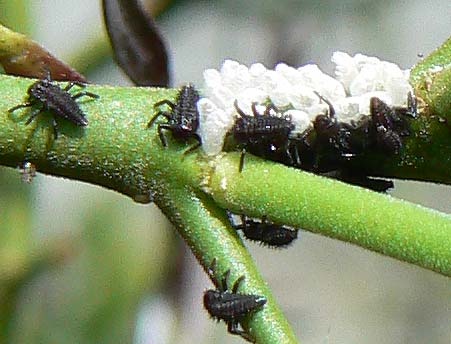
The Harlequin Ladybird is a recent arrival to the UK, but it is already very common
in southern England. It loves to overwinter in large numbers in nooks and crannies
of houses where it becomes a considerable nuisance. Although it rapaciously
devours many garden pests, it is generally considered 'a bad thing' because,
when pests run out, it apparently turns on the native British ladybird. Having
watched a Harlequin larva feast on one of its own siblings (photo below), I can well believe the smaller British relatives would stand no chance, However, my greenhouse has plenty of aphids, and I could see no reason against moving a number of adult Harlequins out of a relative's house and into my greenhouse. This is a photographic record of what happened. |
The adult Harlequins soon seemed to disappear, but I then noticed a patch of red
eggs on an aphid infested citrus where I had released them. A few days later, the
black larvae emerged, leaving crumpled, white egg sacks behind. Eggs and the
just-hatched larvae are about Imm long. |
The larvae grew rapidly on a plentiful diet of aphids, shedding their skin several
times, and developing prominent red markings. On one occassion, an adult
larva was observed feeding on another of similar size! Length finally about
8-10mm before pupating. |

....friend or foe? |
Harmonia axyridis |
page created 11th May 2008 |
Here is a pupating larva attached to the underside of a leaf, about 4 weeks from
hatching. The adult ladybird emerged a week later. To my surprise it had no markings
- they were left behind on the discarded pupa case. I'm not sure whether
the adult ladybird developed markings in the next few hours. When I searched the
next day, I couldn't find a ladybird without spots! |